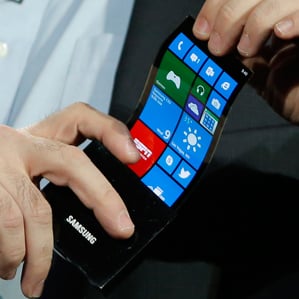Manufacturing Advances Mean Truly Flexible Devices Are on the Way
One of the innovations packed inside the Apple Watch—and highlighted by designer Jony Ive at the company’s grand unveiling this week—is a flexible display.

Contrary to some earlier speculation about the device, however, this doesn’t mean you can actually bend the screen. As with other devices featuring flexible displays, such as those from LG and Samsung, the display has been laminated onto a stiff pane, fixing it in place to prevent the damage that would come from repeated flexing.
Even so, the appearance of the first few flexible screens in commercial devices may be a sign of things to come. In fact, fully flexible electronic gadgets—with full-color displays that wrap around a wrist or fold up—may be just a few years away, thanks to solutions that manufacturers have already started to demonstrate.
Apple hasn’t disclosed why the Apple Watch has a flexible display. It might allow for a slight curve at the edges, and it may also simply be thinner than a conventional one (see “The Apple Watch May Solve the Usual Smart Watch Annoyances”).
In a conventional LCD display the liquid crystals within the pixels need to be perfectly positioned between two sheets of glass. These sheets cannot be bent without misaligning the pixels. According to Max McDaniel, chief marketing officer for Applied Materials, a company whose equipment is used to make displays, is also extremely difficult to make a flexible backlight—the component needed to illuminate LCD pixels.
So the screen in the Apple Watch is almost certainly an OLED display. Rather than the pixels being illuminated by a backlight, each pixel glows on its own, like a minuscule light bulb. Manufacturers can already make OLED displays flexible. They first laminate a sheet of plastic to glass and then deposit the materials for the pixels and the electronics on top of both. The glass stabilizes the manufacturing process, and afterwards the plastic, together with display and electronic components, is lifted off the glass.
Manufacturers have known how to do this for years. Samsung showed off a fully flexible OLED display in 2013. The tricky part is making sure the devices are durable. OLED pixels can be destroyed by even trace amounts of water vapor and oxygen, so you have to seal the display within robust, high-quality, flexible materials. This is costly, and there are challenges with ensuring that the seal survives being bent hundreds or thousands of times over the lifetime of a device.
The parts within a flexible display also need to survive being bent. This is tricky because different layers—the battery, the electronics, and the touch components—tend to be stacked, and the innermost layers have to bend more than the outermost ones. The outer layers also stretch while the inner ones compress.
Some researchers have developed stretchable electronics, which might help accommodate stresses (see “Stretchable Displays” and “Making Stretchable Electronics”). Novel materials for touch screens that use flexible nanomaterials could also help. One patent application suggests Apple is already looking at this issue. It describes measures such as varying the thickness of materials in a device to allow it to bend while keeping the electronics lined up properly with the pixels they control.
Making a flexible battery is another challenge. While the lithium-polymer batteries used in smartphones today are somewhat flexible, they can’t survive being bent many times. One option is to make a segmented battery, like a segmented watch band, says Kevin Chen, general manager for energy storage solutions at Applied Materials. His company is developing solid-state batteries, which could easily be cut up into small pieces for flexible devices, and which also have the potential to store much more energy than conventional lithium-ion batteries (see “Longer-Lasting Battery Is Being Tested for Wearable Devices”). Apple outlines a similar battery design in another recent patent application.
Steady progress means fully flexible devices could be available in just a few years. Meanwhile, we have flexible displays that are fixed in place—as in the Apple Watch.
Keep Reading
Most Popular
Large language models can do jaw-dropping things. But nobody knows exactly why.
And that's a problem. Figuring it out is one of the biggest scientific puzzles of our time and a crucial step towards controlling more powerful future models.
The problem with plug-in hybrids? Their drivers.
Plug-in hybrids are often sold as a transition to EVs, but new data from Europe shows we’re still underestimating the emissions they produce.
Google DeepMind’s new generative model makes Super Mario–like games from scratch
Genie learns how to control games by watching hours and hours of video. It could help train next-gen robots too.
How scientists traced a mysterious covid case back to six toilets
When wastewater surveillance turns into a hunt for a single infected individual, the ethics get tricky.
Stay connected
Get the latest updates from
MIT Technology Review
Discover special offers, top stories, upcoming events, and more.